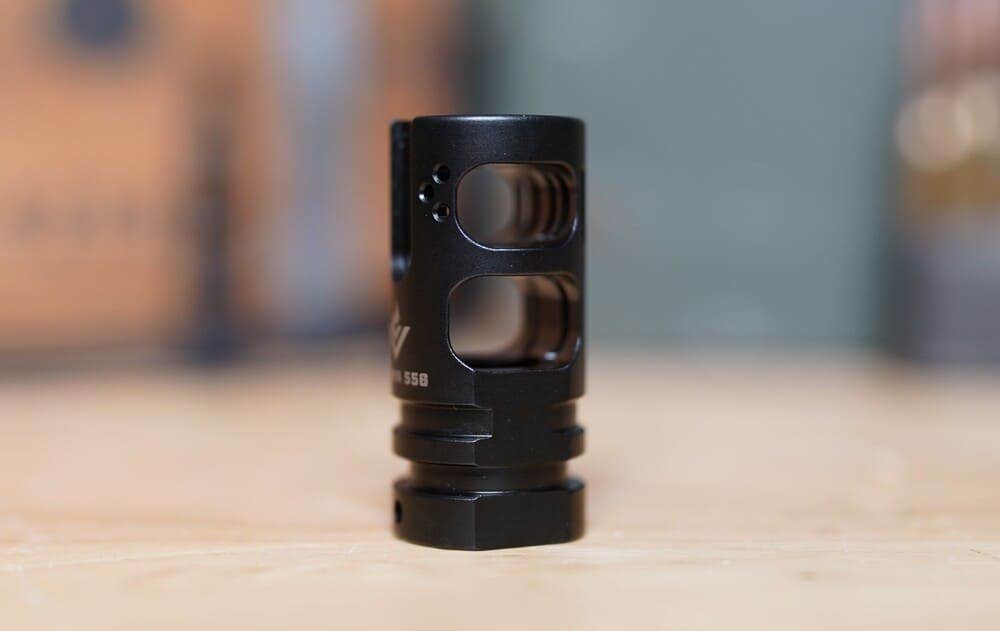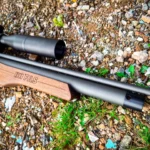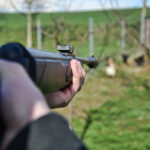Have you ever wondered how a flash hider actually works, or what’s inside a suppressor? Confused about the difference between a brake and a compensator? Or maybe you’re just curious which muzzle device will help you shave a second or two off of your competition time – whatever the case may be, you’re in luck, because we’re doing a deep dive on the different types of muzzle devices and exploring the pros and cons of each one.
Table of Contents
Flash Hider
While the name is fairly self-explanatory, the science behind flash hiders (also known as flash suppressors) is more complicated than you might think.
When a bullet is fired from a typical long-barreled rifle, most of the propellant is burned before the bullet exits the barrel. But with a shorter barrel, where there isn’t enough time for the powder to be fully consumed, the result is an almost instantaneous two-stage muzzle flash – the primary flash is caused by super-heated propellant gases trailing behind the bullet, and the secondary flash is caused by residual gases that ignite after being exposed to oxygen in the air, creating the infamous “fireball” that you’ve probably encountered if you’ve ever fired an SBR or shot a firearm without a flash hider (especially at night).
This created an obvious problem as militaries around the world began shifting towards shorter, more maneuverable carbines – while increased muzzle flash also made the shooter a more visible target, the bigger problem was that it significantly impacted the shooter’s vision during night-time engagements, and in extreme cases could even cause temporary blindness.
One of the earliest examples of a flash hider can be seen with the clamp-on conical flash suppressors used on Lee-Enfield Jungle Carbines in the later years of World War II, but the example that most shooters are probably familiar with is the A2 “bird cage” flash hider that comes standard on most AR-pattern rifles. But how does it actually work? The answer is that the holes or gaps in the flash hider divert the super-heated gases from the primary flash, while also minimizing oxygen flow and rapidly cooling the residual gases to reduce or eliminate the secondary fireball effect.
If you’re shooting a carbine or short-barreled rifle, often shoot at night, or frequently use cartridges that either require large powder charges or the use of slower-burning powder, a flash hider is going to be your best friend.
Muzzle Brake
When you fire a gun, the energy created by expanding gases is used to propel the bullet forward. And if we recall Newton’s Third Law of Motion, that means the same energy is exerted in the opposite direction, resulting in what we feel as recoil. In order to reduce that recoil, those gases need to be redirected – and that’s exactly what a muzzle brake is for.
While brakes were first invented to tame the recoil of artillery and vehicle-mounted gun systems, they eventually made their way over to the world of small arms as well. They became especially useful for reducing the recoil impulse of large-bore rifles and anti-materiel weapons, often cutting the felt recoil by as much as 50%.
In simple terms, a brake works by redirecting gases backward, typically at a 45-degree angle to the shooter. In effect, this “pulls” the weapon forward, counteracting recoil. Some muzzle brakes also come with one or more expansion chambers cut into them, which help to bleed off escaping gasses and reduce their momentum, further reducing recoil.
So who needs a muzzle brake? Typically, anyone who is shooting big-bore firearms with otherwise unmanageable recoil, though they are also popular among many medium-bore hunters who may have to fire from awkward positions or who want to be able to spot their hits at longer distances. They are also a common choice for shooters putting together lightweight rifle builds, since the reduced mass makes recoil more noticeable and there are many muzzle brakes constructed of lightweight aluminum or polymer that add negligible weight.
As with all muzzle devices, there are some trade-offs: the gasses diverted by a muzzle brake are still moving very quickly, increasing the perceived decibel level and concussive force of each shot for anyone who is in their path. If you’ve ever had the privilege of going to an indoor range and ending up next to someone running a brake, you know just how unpleasant it can be. Those gasses can also kick up dust and debris if you’re shooting from a prone position, which is something to keep in mind for those who live in drier climates.
Compensator
While some will argue that a compensator is just another type of muzzle brake, they perform a specific enough role to merit their own separate discussion. Whereas a muzzle brake is intended to lessen felt recoil, a compensator is intended to reduce muzzle climb (also known as muzzle flip). To accomplish that, there are two basic compensator designs: linear and radial.
A linear compensator redirects gas in a straight line forward of the shooter, reducing some of the noise and concussive force of the muzzle blast and making the firearm more comfortable to fire for the user and anyone standing nearby. Because they reduce muzzle climb less than a radial compensator, linear compensators are typically seen on short-barreled rifles or AR pistols, where recoil management is less of an issue than the decibel level and shockwaves generated by each shot.
A radial compensator usually (but not always) vents gases at a 90-degree angle to the shooter, and can often be identified by the holes, or “ports,” cut into it. Because each compensator must be specifically designed to suit the shooting platform it is intended for, there are naturally some unusual designs floating around, as well; the most famous example is probably the iconic AKM “slant brake,” which actually isn’t a brake at all – it is an aggressively angled compensator that is canted roughly 22 degrees off center to the muzzle in order to counteract the natural up-and-to-the-right recoil pattern of the AKM when fired by a right-handed shooter.
While compensators are great at what they do, and are a frequent mainstay of competitive events that require the shooter to deliver fast follow-up shots, there are a few things to keep in mind. Like muzzle brakes, most radial compensators will make even a relatively soft-shooting cartridge painful for everyone else around you, and the ported holes effectively shortens your barrel length, resulting in some loss of velocity. As well, linear compensators can create a very small amount of turbulence at the muzzle crown due to some of the gases actually being pushed out of the barrel faster than the bullet – for the vast majority of shooters, this effect will be unnoticeable, but those who are interested in extreme long-range shooting or precision benchrest shooting will likely want to look elsewhere.

Suppressor
First things first: No, “silencers” aren’t really silent. Suppressors reduce a firearm’s muzzle report by reducing the speed and pressure of the gas created when a cartridge is fired, and while the effect can be significant, it’s not as dramatic as Hollywood would have you believe.
Suppressors work by using a series of sound baffles to create a sort of “maze” for the gases to navigate, causing them to slow down and cool off enough to reduce the sound of the gunshot. These baffles are usually made of a lightweight metal such as titanium or aluminum, though a few manufacturers have successfully used plastic baffles for .22 LR suppressors. These baffles can either be machined out of a single piece of metal, in which case they are called a “monolithic core” suppressor, or they can be manufactured in multiple pieces and combined in a “baffle stack” suppressor.
Generally speaking, a monolithic core suppressor will be less expensive, easier to clean, and less prone to experiencing a baffle strike, while a baffle stack suppressor will be slightly quieter, shorter, and able to make use of alloys such as Inconel that are more efficient but also more difficult to machine into a monolithic design.
While suppressors are by far the most expensive muzzle device on this list, and also require the extra expense and legal headache of securing an NFA tax stamp, they are a great all-around option for those with enough patience and money. Not only does a suppressor dramatically reduce noise, it also eliminates muzzles flash by cooling the gases as they travel through the baffles. Not only that, muzzle climb and felt recoil are slightly reduced thanks to the reduced energy of the gases and the added weight and length of the suppressor. They’re an increasingly popular choice for hunters who don’t want to scare off nearby game or use bulky ear protection, and if you’re building a rifle for home defense, a suppressor will ensure that you are not temporarily blinded by muzzle flash in a dark room or subjected to permanent hearing damage.
The Bottom Line
As is often the case when it comes to firearm accessories, choosing the best muzzle device for your needs ultimately comes down to your mission. While the standard flash hider that comes mounted on many modern rifles is perfectly adequate for most situations, upgrading your muzzle device is often a relatively inexpensive way to squeeze some extra efficiency or better performance out of your gun, whether you want a jack-off-all-trades tool or a highly specialized setup.














































